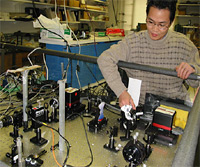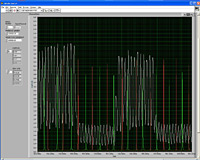 |
|||||||||||
|
|||||||||||
|
|||||||||||
Because high precision measurements will be the hallmark of experiments at the International Linear Collider, the project will require a detector with highly technical components to accurately measure the properties of the emerging particles. From beam position monitors to measuring particle flow, groups of physicists at universities across the U.S. are contributing to detector designs for the ILC. A group of researchers at the University of Michigan is contributing to international studies on the charged particle tracker, a critical component that measures the trajectories of electrically charged particles as they cross a magnetic field. By measuring how much the field bends the particles, physicists can determine their energies. For particles traveling close to the speed of light, however, this bending is minimal and difficult to measure. Silicon microstrip detectors are a leading candidate for finding these small deflections. Consisting of multiple layers of thin silicon planes, these microstrips measure the passage of charged particles to a statistical precision better than 10 millionths of a meter, or 10 microns. The position and stability of the silicon layers play a large role in achieving accurate measurements, making it very important to minimize any disturbances to the ultra light strips. Using a technique called Frequency Scanned Interferometry (FSI), the University of Michigan research team has monitored and corrected changes in the positions of these silicon layers so accurately that any uncertainties in measuring the energies of charged particles is negligible. This FSI method simultaneously measures the absolute distances between hundred of pairs of reference points on the detector to a precision of more than one micron. Those individual measurements are then combined to infer the positions, rotations and shape distortions of the silicon layers. All of the absolute distances are part of an optical interferometer system, in which the frequency of the laser light is scanned continuously to create a changing interference pattern of shades of light. By studying this pattern, physicists are able to determine each measured distance. In December 2005, the University of Michigan group successfully carried out measurements on an optical bench, which mimicked the conditions of a silicon detector. Using the FSI technique with a dual-laser system, the group confirmed achievable precisions of .2 microns, under realistic, fluctuating environmental conditions. With a precision that exceeds requirements, this achievement confirms that the FSI technique is promising for the International Linear Collider. Next the University of Michigan group will miniaturize the components used in this study and test them to verify that the low-mass requirements of an alignment system can be satisfied. When a silicon detector prototype becomes available, further testing will be conducted. -- Keith Riles, University of Michigan |
|||||||||||
| © International Linear Collider |

